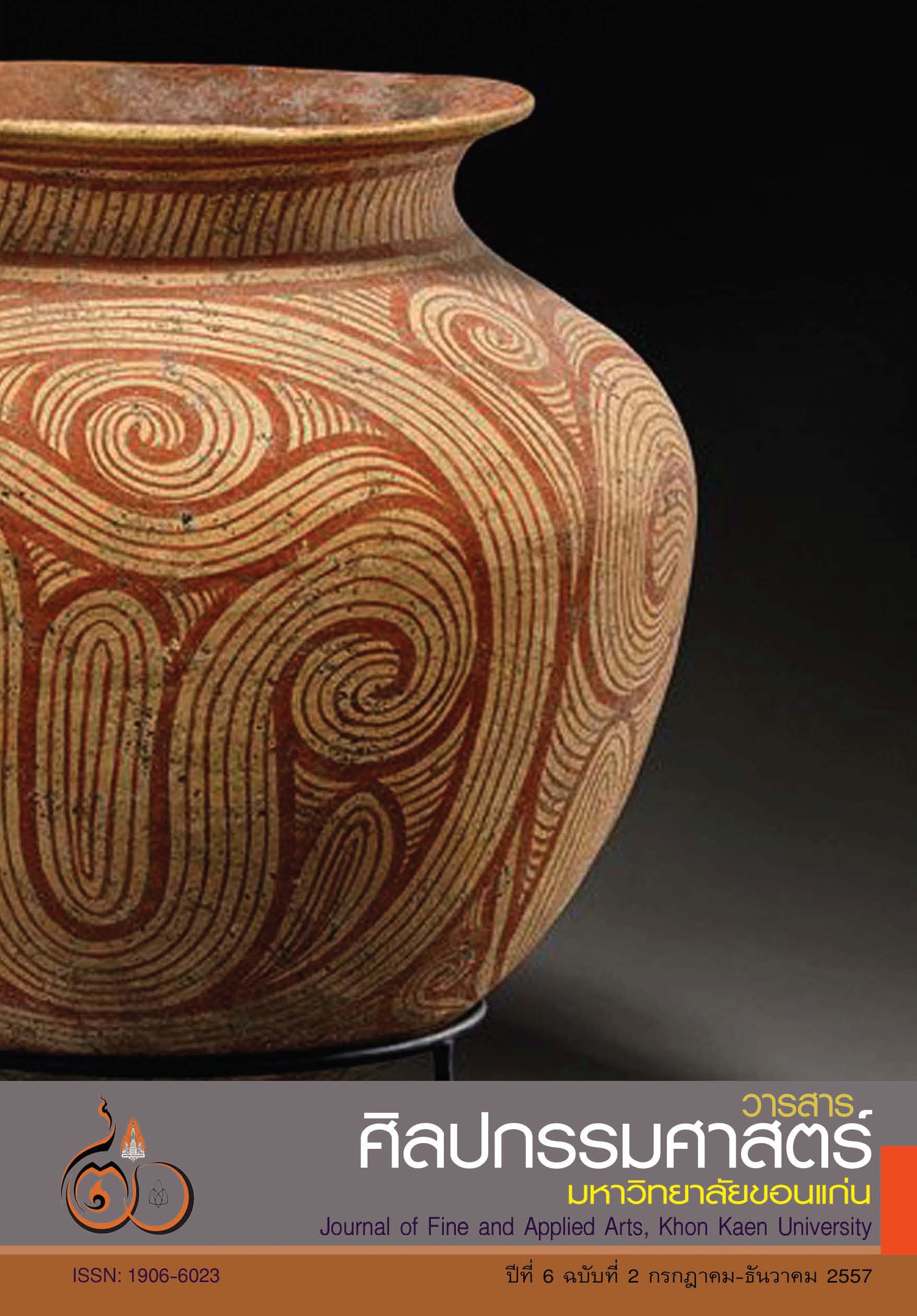เพลงปี่ตามบทของพระอภัยมณี กรณีการบรรเลงปี่ของครูปี๊บ คงลายทอง Instrumental solo of Pi, the Thai quarduple-read, perform in Pra-apaimanee, the Thai literature : a case study of master Peeb Khonglaithong’s performance
Main Article Content
Abstract
การวิจัยมีวัตถุประสงค์เพื่อ ศึกษาประวัติและผลงานทางด้านดนตรีของครูปี๊บ คงลายทอง โดยเจาะประเด็นการวิเคราะห์เพลงปี่ในบทของพระอภัยมณีครั้งที่บันทึกเสียงร่วมกับการขับร้องของครูแจ้ง คล้ายสีทอง สามารถนำลักษณะการสื่ออารมณ์ด้วยเทคนิคต่างๆของครูปี๊บ คงลายทองมาเป็นแบบอย่างและยังเป็นการเผยแพร่วัฒนธรรมไทยทั้งในด้านดนตรีและวรรณกรรมให้แก่ผู้ที่มีความสนใจ โดยศึกษาจากการสัมภาษณ์และเอกสารที่เกี่ยวข้อง ผลการวิจัยพบว่า ครูปี๊บ คงลายทอง อยู่ในครอบครัวดนตรีไทยมาตั้งแต่สมัยคุณปู่ บิดาคือครูเทียบ คงลายทอง นักปี่ผู้มีชื่อเสียง จึงมีโอกาสฝึกปี่ที่บ้าน และได้เข้าศึกษาที่วิทยาลัยนาฏศิลปะมีครูบุญช่วย โสวัตร เป็นผู้ช่วยสอนอีกท่านหนึ่ง ด้วยบริบทที่กล่าวมาข้างต้นสามารถเป็นหลักฐานยืนยันถึงความเชี่ยวชาญทางด้านการบรรเลงปี่ของครูปี๊บ คงลายทอง จากการศึกษาการบันทึกเสียงการบรรเลงเพลงปี่ในพระอภัยมณีของครูปี๊บ ทั้ง 9 เพลง พบว่าลักษณะการบรรเลงของครูปี๊บ มีความชัดเจนทางด้านการสื่ออารมณ์ การดำเนินทำนองของปี่ในแต่ละบทเพลงเคลื่อนที่ไปในทิศทางเดียวกับผู้ขับร้อง ส่วนใหญ่มีลักษณะการเคลื่อนที่ของโน้ตที่ไม่กระโดดมากนักนอกจากบางช่วงที่เป็นการเอื้อนของผู้ร้องที่มีการกระโดดปี่จึงบรรเลงไปในทิศทางเดียวกัน ทั้งยังใช้เทคนิคต่างๆที่แสดงถึงฝีมือและประสบการณ์ของผู้บรรเลงได้อย่างดี บทบาทหน้าที่ของเพลงต่างๆในบทของพระอภัยมณีนั้นทำหน้าที่สื่อสารเนื้อเรื่องของบทละครไปสู่ผู้ชมโดยแต่ละเพลงที่ศึกษานั้นใช้ปี่เป็นทำนองหลักคู่ไปกับผู้ขับร้อง
This research aimed to study the background and musical works of Khru Peeb Khonglaithong by emphasizing on the musical analysis of Pi Song (song played by Thai traditional double-reed oboes) from Phra Aphai Mani folklore when jointly recorded with the singing voice of Khru Jaeng Klaisithong. In addition, this research was conducted to study diverse techniques used by Khru Peeb Khonglaithong in expressing different emotions to be used as a model and to promote Thai culture in terms of music and literature among those who are interested. The research instruments employed included interview and relevant documents. Based on the research results, it can be found that Khru Peeb Khonglaithong was born in a family of Thai musicians since his grandfather’s generation. His father was Khru Thiab Khonglaithong, the renowned Pi player, which gave Khru Peeb the opportunity to practice playing the traditional music instrument at home. He later joined the College of Dramatic Arts where he was taught by Khru Bunchui Sowatr. The prescribed factual information has clearly proven Khru Peeb Khonglaithong’s expertise in the field of Pi song. Upon analyzing the nine Pi songs from Phra Aphai Mani played by Khru Peeb, it can be discovered that Khru Peeb’s style clearly define and express emotions. The tunes in each song harmoniously moved along with the singer’s voice. Most of the notes played were normal, with the exception of the time when the singer jumped from one note to another that the instrument’s note would follow in the same direction. In addition, the techniques applied had reflected the skills and experience of the player relatively well. The role of each song from Phra Aphai Mani was to carry the message of the story to the audience. In this research, each selected song used Pi as the main musical instrument to play along with the voice of the singer.
Article Details
Content and information in articles published in the Journal of Fine and Applied Arts of Khon Kaen University is regarded as the opinion and sole responsibility of the author(s) directly; therefore, editors are not obliged to agree to or share any responsibility with regard to the content and information that appears within these articles.
All articles, information, content, image, etc. that have been published in the Journal of Fine and Applied Arts of Khon Kaen University is the copyright of the Journal of Fine and Appllied Arts of Khon Kaen University. Any person or organization who wishes to distribute all or parts of the articles for further dissemination or other usage must first receive permission from the Journal of Fine and Applied Arts of Khon Kaen University before proceeding to do so.


